Parul and I decided to visit Burma / Myanmar for a vacation in late February 2016. We ended up getting three full weeks to travel the beautiful country. In a country like Myanmar that has a rapidly evolving tourism industry, I intend to fill the gaps that I found while trying to plan a trip myself. That and a first hand narrative of the wonderful experiences that we have had.
This post is for the second leg of travel - Mandalay (2 Mar 2016 - 5 Mar 2016).
Irrawaddy River Cruise
We checked out really early the next morning and the cab was waiting for us by the time we got downstairs. It was a rather short ride to the jetty and hardly worth the money that we paid for. Could have easily walked the distance in 30 minutes or so. There were two boats docked at the jetty. A man checked our tickets and pointed to the smaller of the two. The few passengers we could see were on the bigger one. Parul was apprehensive that she would be able to cross the wooden plank to the boat without falling while I was dreading that the boat ride would be a repetition of our shared cab to Mount Popa. Both of us were in the wrong though. Parul made it to the boat without incident and we knew that we had more travellers on the boat when we dumped our luggage on a pile of bags.
We were not many though. Apart from the two of us there was a group of three Dutch travellers, one man and two women. We were joined by another female before the boat departed. All the travellers other than us were a little advanced in years. I would have put them in their early sixties. Myanmar seemed to be a place where you could see a considerable percentage of older travellers. I think it was because of the romance of the place that Kipling’s poem had created in that generation. Or maybe it was because what the country had to offer. The neighbouring countries held more charm for the younger population, though we did find a lot of them as well.
Both the boats started off in quick succession, the other boat (MGRG) a couple of minutes before ours (Malikha). There seemed to be more people on board the MGRG boat. Once again, it was a difference that online presence had made. Malikha was comfortable enough; had a nice deck, reasonable food options, clean toilet, enough seats to sit or sleep in. Though I suppose MGRG had more amenities, there was a considerable price difference as well. Malikha had cost us 30 USD while MGRG was more than 40.
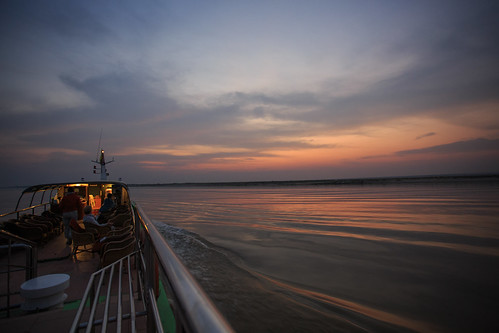 Early morning departure
Early morning departure
An orange glow on the eastern sky announced the spot that the sun would come up. The sceneries were quite amazing. The sky was somewhat cloudy but it did not blotch the beauty of the sunrise. Since Parul was taking pictures, I realised that this was one of those rare occasions when I could actually enjoy living the moment rather than spending time capturing it. It has become a compulsive habit that I am not too fond of. The story that plays in my mind demands pictures, and so, as if by reflex, I pull out my phone and start clicking. I sat down and enjoyed the wind. We were cruising comfortably at about 15 kmph. The river’s dark waters brightened. It was a calm and steady surface broken only in the wake of the two boats.
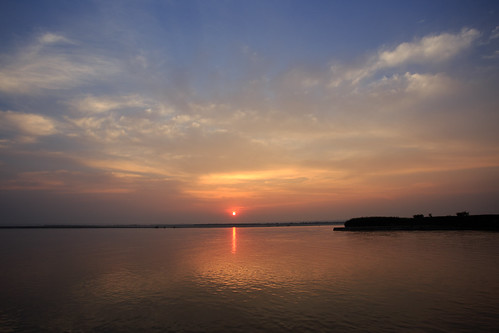 Sun rising over the Irrawaddy
Sun rising over the Irrawaddy
The moon had not yet vanished from the sky when the orange glow turned to a shade of red and there appeared a circular embodiment of the light. Small birds, the species of which I am unaware of, were flying along the surface of the river, possibly looking for a morning snack. Fishing boats had started plying over the Irrawaddy. The river had come alive! Both of us thought that this one was better than the one we had seen a couple of days ago from the crowded Bulethi Pagoda in Bagan. If not for the continuous hum of the boat’s engine, it might even have been one of the best settings that I have been a part of in my life!
I fell asleep on the deck and had a comfortable three hour sleep. The cold wind and warm sun were striking a perfect balance. Eventually the sun grew hotter and I moved indoors to less lazy activities like reading and writing. The Innwa bridge came into sight around 3:30 PM announcing Mandalay’s approach. The pagodas of Sagaing came into view and within another hour our boat had reached the jetty and we were picking our luggage and thanking the staff before deboarding the boat. The old folk took a taxi while we decided to walk the four odd kilometers to the Hotel.
 Innwa Bridge and the pagodas of Sagaing
Innwa Bridge and the pagodas of Sagaing
That night we started exploring the amazing food scene in Mandalay. We went to a famous Shan food place a little far away, Golden Shan. It was supposed to be a typical Shan buffet but by 9:30 PM some of the dishes were already gone. The food was pretty good though. We had seen a “Dagon Beer Station” on the way and thought we would hang around a bit before heading back to the hotel. But by the time we were returning, even that had shut down! Mandalay slept early as well. We were expecting different from the city.
Ancient Capital Region
We had a decent hotel in Mandalay. It was a tad bit expensive but that was to be expected of a city. Weirdly, we could not find any listings of hostels in Mandalay. The one that was listed was offering extremely expensive dorm beds. Perhaps the hostel culture has not yet invaded the country despite the tourism boom.
We had decided to cover the more distant parts of Mandalay on the first day. These were places of historical significance like Mingun, Sagaing and Amarapura. They were spread out across the two banks of the Irrawaddy. We were on the eastern side of the river. Mingun and Sagaing happen to be bang on the opposite side. There are a couple of daily ferries that ply between Mandalay and Mingun, allowing tourists a decent enough time to explore the ruins of the old town and then return to Mandalay. But we decided to rent out a bike instead and explore on our own.
The bike that the hotel arranged for us was something of a novelty for me. It was a clutch-less geared system. It took me a while to figure out how it worked. And all the time I had a feeling that I was doing something horribly wrong; that I was mistreating the engine by changing gears without a clutch. But this was the vehicle of choice in the city and everyone was riding it in a similar manner. Almost immediately after leaving our hotel, the bike stuttered to a stop and refused to start. While I frantically tried the ignition and the kick start, a man walked up to me to indicate that the bike was out of fuel. Great! Mandalay’s road side fuel sales came to the rescue and we were finally off to Mingun. We refueled once more at an actual petrol pump on the way to find out that the price difference between road side and pump fuel was almost 80%! Or maybe it was just standard tourist price that we had paid for the bottle of petrol.
Mingun
Mingun is to the west of the Irrawaddy and to get there from Mandalay you need to go south, cross the Mandalay bridge to Sagaing and then head north along the river to Mingun. The road till Sagaing was a nice and broad one with heavy traffic and toll collections. It was nothing exceptional in any way. But once we took the river side road from Sagaing, things got interesting. Past the town, the road winded through small hamlets scattered on the roadside. Untamed countryside went past us with its hues of brown and green. There was little greenery this time of the year since it was the dry season. The rural landscapes were quite similar to what we are accustomed to back in India. The only difference being the numbers. I think that is, in essence, what differentiates Myanmar from India. This country seemed a less crowded version of our own. The roads and landscapes were similar; the daily engagements of people were familiar; the food was awesome; the people were friendly, easily intrigued by foreigners.
One of the villages that we passed had a rather elaborate Shinbyu ceremony going on. We stopped our bike and walked up to the crowd of people clogging the narrow street. There were pick up trucks lined on one side, to be stuffed with the crowd that was celebrating on the street. The boys who were to be initiated into monkhood sat decorated on plastic chairs with a nonchalant attitude to the hullabaloo around them. The families celebrated with zest! A dancing troupe with tribal getup was dancing to English numbers from 2010; Pitbull, Jeniffer Lopez and Shakira.
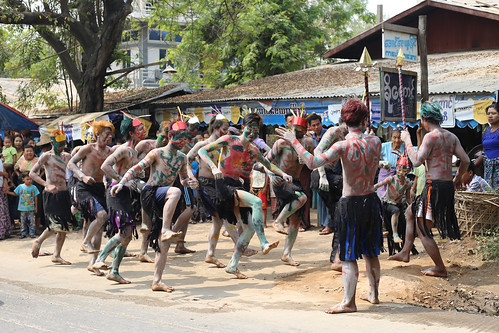 Shaking a leg to Pitbull
Shaking a leg to Pitbull
Apart from the striking mismatch between the sound and the getup, they seemed to be all well coordinated and danced rather well. The villagers stood around, some watching in amusement while a few inebriated men danced along in less coordinated steps. Their wives ran around collecting them when they got too close to interrupting the professionals and they simply continued dancing wherever they were left.
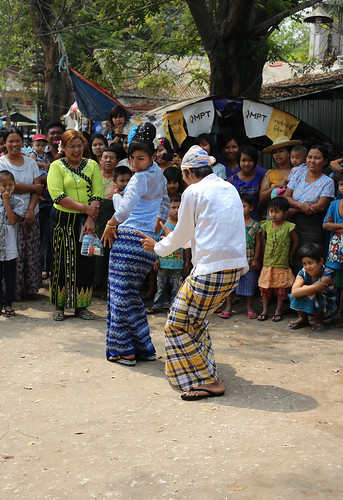 Villagers enjoying a musical skit
Villagers enjoying a musical skit
After the tribal dance, we were treated to a musical skit. It seemed to be about the tussle between a man and a woman, seemingly lovers. In the typical fashion of rural sense of amusement, it got a little lewd but entertaining nonetheless.
Another very evidently drunk man offered us watermelon slices as we stood watching the ceremony. I took one in order not to be rude. He would demand money for it later but a rebuke from his wife would make him hasten to return me the money I offered.
Pro Tip #3
Drunk men are simply drunk men, no matter where you are. Stay clear or deal politely, latter being more amusing.
We had spent close to half an hour watching the ceremony before we decided to get going. We had come only half of the 40 odd kilometers between Mandalay and Mingun. We rushed on the well tarred roads and after passing some more pretty villages, reached the spot along the Irrawaddy that was chosen for one of the most ambitious projects in the world. We bought tickets to for the Mingun-Sagaing region (worth 5000 MMK) from one of the counters and went further to check out the stupas.
Parul also bought one of those conical cane hats that she had been fancying for a while and went into the next level of her Burmese mode. She liked to believe that she was Po but then who doesn’t!
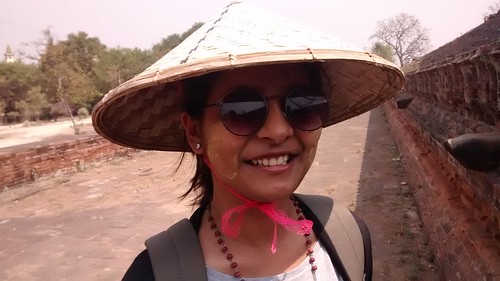 Parul : Burmese Level 2
Parul : Burmese Level 2
The Pathodawgyi is a remarkable sight. It was intended to be a 150 meters tall stupa with two massive lions sitting on the eastern entrance. Due to a prophecy that the king would die when the stupa was completed, the project was abandoned and stands as an incomplete reminder of the grandeur and superstition of yore.
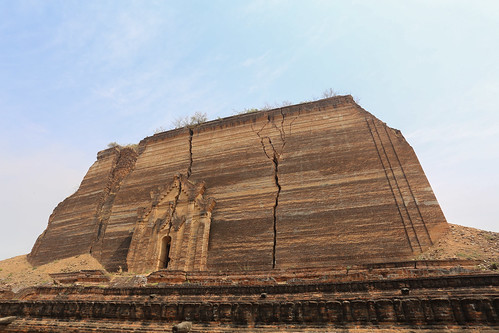 Imposing Pathodawgyi
Imposing Pathodawgyi
We walked around its compound, straining our eyes to see the cracked walls of the monument in the blazing sunlight. The immense stupa had been ravaged by the earthquakes of 1839 and much of the structure had cracked or collapsed. Wilderness laid claim to portions of the monument with tall grasses and bushes growing out of cracks in the ground and the building. Parul even saw (and I heard) a snake slither past near where we were. By her description, it was green rat snake. We tried finding it again but it had run away into hiding.
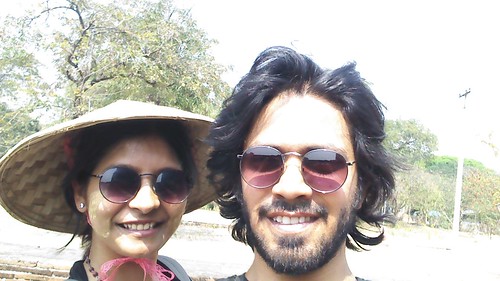 Selfie in the blazing sun
Selfie in the blazing sun
A warning said that climbing up the stupa was dangerous but since there was a proper staircase built, we decided to climb up all the same. The bricked surface of the monument was scorching and we tried finding respite in any shaded spot that we could find. At the top of the stairs a group of boys were idling around smoking cheroots. They mingalabar‘ed us as we passed and asked if we could get a few pictures clicked with them. We obliged with a laugh.
The effects of the earthquake were much more evident up top. The entire surface was broken up and had collapsed into itself. Bushes grew out of every crack that afforded enough space. We walked to one of the ends (northern one) and took in the view. It was quite a vantage point and we could see the nearby lands sprawling around. The Mingun Bell and Hsinphyumae Pagoda lay to the north.
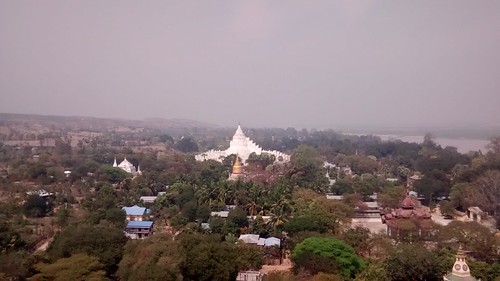 View from up top
View from up top
We did not bother with the rest of the sides as the heat was getting unbearable. We carefully found our way down the stairs and went back to collect our shoes.
We went and saw the Mingun Bell next. This massive bell is more than 90 tonnes in weight and rings when it is struck. It was meant to go with the huge stupa next to it but when the Pathodawgyi was abandoned, the bell slowly passed into delinquency. We spent a few minutes playing around it. There were a lot of people, tourists and locals alike, clicking pictures and hitting the surface with wooden pieces to make the bell ring.
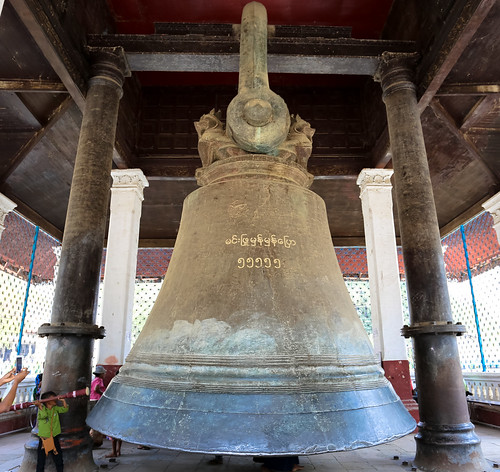 Mingun Bell
Mingun Bell
Next to the bell was the Hsinphyumae Pagoda. It is a white pagoda which is built in a very different style from the other pagodas. The terraces represent the mountain ranges going up to Mont Meru. The view from up top was nothing exceptional; we had seen a better view from the Pathodawgyi.
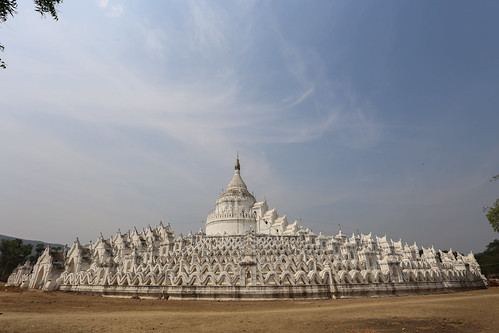 Hsinphyumae Pagoda
Hsinphyumae Pagoda
We spent some time loitering around and clicking pictures and then went down to get our scooter and headed back towards Sagaing. On the way we stopped at a place for lunch. They were not serving food for some reason. We could not understand why but maybe it was because of the time, too late of too early. They did have some really awesome coconut buns though. We ate a plate of those and they filled us up enough to survive till the evening.
 Delicious coconut buns!
Delicious coconut buns!
Innwa
We decided to skip Sagaing. We had had our fill of pagodas and stupas in Bagan. We decided to go to Innwa instead. Innwa was the ancient capital of Burmese kingdoms from the 16th to 19th centuries. The earthquake of 1839 (the same one that cracked the Pathodawgyi) completely destroyed the place and the capital was then shifted to Amarapura. We biked back to Sagaing and then took the Innwa bridge to the east of the river. This time we headed south and came across a stream. The ruins of Innwa lay on the other side of this stream. There was a boat service that offered to take us and the bike for a reasonable return fee of 1000 MMK per person/bike. The other option for seeing Innwa was to rent a horse cart on the other side. We thought about the proposition for a bit and decided to take the horse cart. Parul had been fascinated by it since Bagan and this would be a place as good as any to try it out. We bought two return tickets and boarded the boat with a few other tourists.
Within the minute we were at the other side of the small stream. We got off the boat and our place was taken by other tourists returning from their tour of the ancient capital. We walked on ahead and there appeared a big “horse cart stand” with many drivers offering to take the new tourists out to tour Innwa. They said that seeing the place would take four hours on foot and two hours by the cart. The cart would take us to four main spots. Since we had already decided to take the cart, we quickly booked one for the price of 5000 MMK per person. The horse cart set out down the dusty path through the lanes of Innwa.
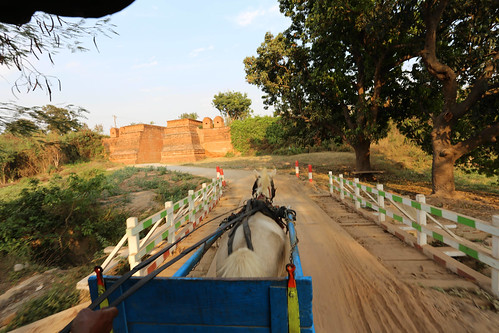 Horsecart ride in Innwa
Horsecart ride in Innwa
Innwa seemed like a forgotten part of history. There was a small village in place of what must have been a bustling capital. The road from the boat jetty to the walled city was a dusty one. The horse trotted at ease, the driver not hastening it for speed. Somehow the cart seemed to fit right in with the surroundings. It seemed but natural to be seeing a place as antique as Innwa in a mode of commutation as outdated as the horse cart. We came upon the gate of the walled city at length and were greeted by a narrow tarred road. The driver turned the cart along the road, leaving behind the gate. Confused, I asked him why we had not entered the gate and he told me in the broken English that he could muster that he was taking us to a pagoda that was ahead. Now this was something that I found rather disappointing. Had we been on our own, we would have stopped at places, checked out the boards telling about the history of the place. The lack of this freedom was why guided tours sucked.
We crossed the southern length of the walls, going further eastward and then turned south for the first stop : Yadana Hsimi Pagoda. This was a pagoda in ruins with not much to see. The derelict Buddha statues and the worn our bricks of the pagodas looked quite different from the gold coated statues that we had seen thus far. A huge tree south eastern corner of the compound added to the authenticity of the ruins. We walked around for five minutes and then went back to the horse cart. At this rate, we would be done in less than two hours. Hiring the cart did not seem like a good decision anymore.
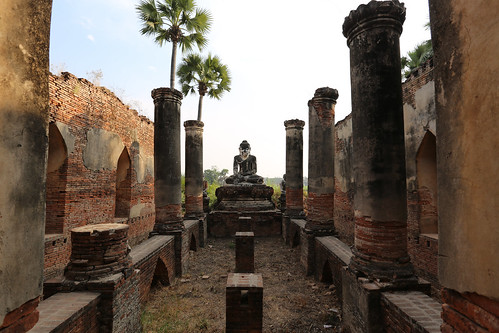
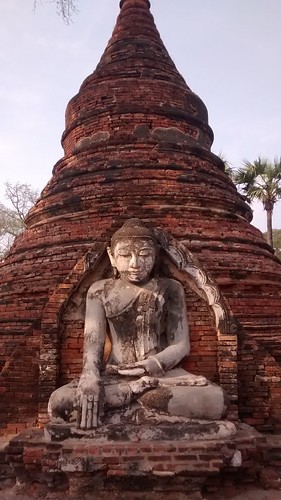 Yadana Hsimi Pagoda
Yadana Hsimi Pagoda
The next site, however, changed our opinion a bit. This was the Bagaya Monastery. We were asked to purchase tickets here. This 10,000 MMK ticket was for the Mandalay archaeological zone and would take care of Amarapura and Mandalay Palace as well.
Myanmar Tip #3
Always carry a good amount of cash on you when you go for sightseeing or are entering a new town. You never know when you might be asked to purchase a ticket, and they are rarely cheap!
The monastery was made of teak wood, in a fashion rather similar to other monasteries that we had and would see. It was raised on stilts and a description said that the biggest teak pillar was 60 feet in height! We walked around the underside of the monastery to inspect the teak pillars, all of which were pretty wide. Then we went up the flight of stairs to the monastery and were quite blown away by the beauty of the wood work. Both, the outside and the inside of the monastery contained some exceptionally well done wood carving. I knew that Burma was the land of teak but this kind of craftsmanship in wood was unparalleled in what I had seen till date.
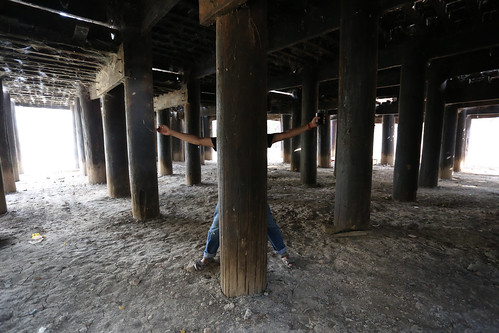
 Fooling around
Fooling around
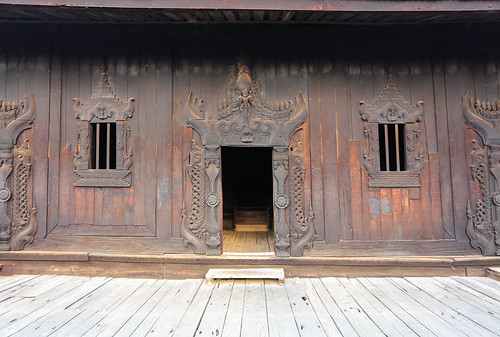
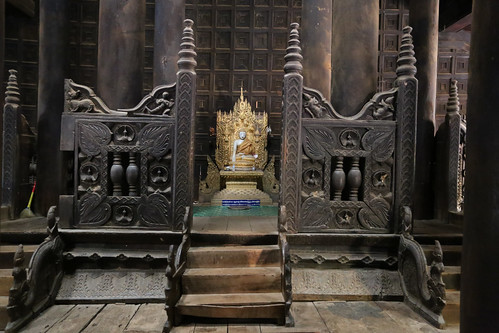
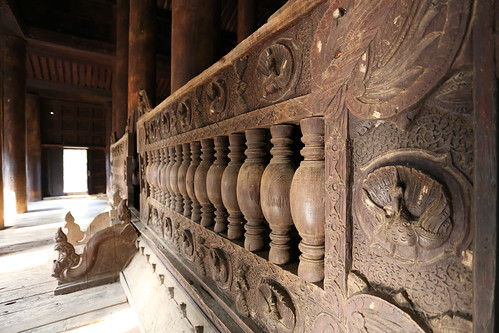 Woodwork at the Bagaya Monastery
Woodwork at the Bagaya Monastery
We took our time walking around the monastery building, taking pictures and enjoying the beauty of teakwood. I saw a few monks around, each partaking in some chore related to the monastery. Though it did not seem like an active monastery, there was probably one in the surrounding buildings. Or maybe the monks came around to help in the upkeep of the building. When we left the building, it seemed that the tour might take the two hours after all.
We rode back to the walled city in the horse cart, entering it from the western gate. At the gate we had departed from the tarred road once again and the horse ambled on the dusty path again. An occasional house presented itself between the farmlands. We did not cross any structure reminiscent of the former glory of the capital. In a distance we could see the Nanmyin Tower, a knocked up watchtower that was the sole survivor of the royal palace of Innwa. Everything else had been flattened by the earthquake. We rode past the watchtower, pausing momentarily to read the history and take a few photos. Climbing the tower was prohibited since the staircase (and probably the tower) was no longer in a state to take strain of tourists.
 Nanmyin Tower
Nanmyin Tower
We rode on to the Maha Aungmye Bonzan Monastery nearby. It was also called the “brick monastery” because the brick architecture that set it apart from the other wooden monasteries. This one did not have exquisite artwork of Bagaya Monastery but it looked impressive in its own sense. The building was huge and built to replicate the wooden monasteries. The yellow complexion of the structure lent a beauty to it that was highlighted by the mellowing sun.
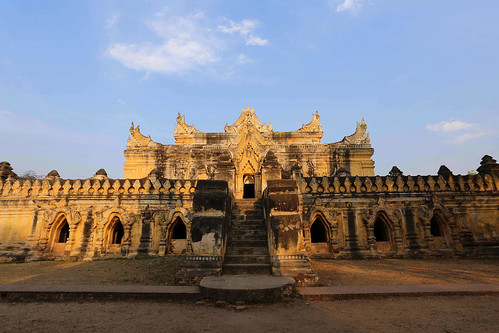 Maha Aungmye Bonzan Monastery
Maha Aungmye Bonzan Monastery
We took a quick tour of this monastery and then returned with the horse cart to the stream crossing.
U Pain Bridge
There was a little time to sunset and there was a bleak chance that we might make it to Amarapura in time. We hopped on the bike and raced to the U Pain Bridge as was marked on Google Maps. We crossed a gathering of people watching a live football match but regretfully could not stop because we were planning to be done with the bridge that day. As we left the highway to take the bylanes of Amarapura, the scene grew less rushed. Groups of men played chinlone every few meters while some people were wrapping up the day’s work. Sunset marked the end of the working day for the people of Burma. They believed in leading a fulfilling life rather than slogging all day long.
We reached the U Pain bridge a little later than what we had planned. All that remained of the sun was a bleak afterglow, but the cloudy sky had rent the setting sun invisible anyway. There were a lot of people on and around the bridge. Some were very clearly tourists or jaywalkers. Others seemed to be walking on the bridge as a matter of daily routine.
We were at the western end of the bridge that sported a pagoda and a lively bazaar. This was clearly the place where tourists came to see the bridge. We went down to the banks of the lake first. People were taking boat rides in the lake. The water looked unclean but that was to be expected with so many people. We clicked a few shots which came out rather well. There was an awful lot of thrash all around though that was difficult to ignore. The lake did not smell however. We also saw a photo shoot going on; a model dressed in white and black being pictured on top of a dead tree trunk. Must have made a rather weird picture for what seemed to be the name of a chic magazine.
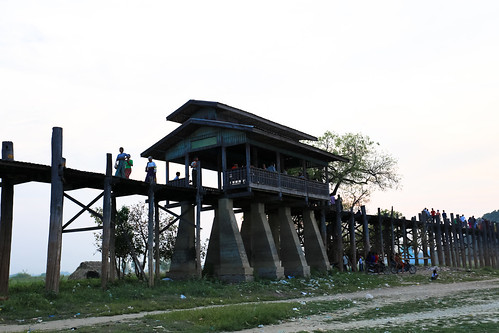 Thrash all around the bridge
Thrash all around the bridge
As it got darker, we climbed on the bridge and decided to walk it’s length and back. U Pain Bridge is considered to be the world’s longest teak bridge at a length of 1.2 kilometers. It is quite amazing to behold. The wood of the bridge looks in good shape despite it’s age (it was built around 1850). It sways a little under the incomprehensible weight that it is subjected to but it does not seem weak in any way. There are small resting points built all along the way, small benches and shades to rest a while or enjoy the view. It was all dark when we were up on it and there was no view to enjoy. There was barely a breeze blowing and the mosquitoes started bothering the minute one stopped. We crossed a few resto-bars built on the lake’s surface which seemed like a nice place to stop for a beer or two. But perhaps when the weather is less oppressive and the evening younger.
We bought a lighter on the other side of the bridge and walked back smoking a cheroot that we had acquired earlier that day. We somehow consumed half of it and left the rest. It seemed like an extremely large beedi. A shorter one would have been appreciated but such a large one was too tasteless and seemed to be a pointless exercise. Yet everywhere you looked in Myanmar, there were people smoking these abominations and chewing beetle. The nation was consumed by these products.
The two and a half liters of petrol that we had filled the machine with were not even half consumed after the day’s trip. We were already pissed that the hotel had given us such a run down machine and no petrol for such an extravagant price. We decided to ride around the Mandalay Palace a couple of times before returning the bike. The palace looked eerily beautiful lit up in the night. The moat reflected the watch towers beautifully. On the southern wall there was a light and music show going on with fountains and all. Locals and tourists were to be seen leaning on the railings watching the amusing show. We saw a few vehicles going inside the palace gate and decided to go check it out. A military officer stopped us hurriedly as we approached.
We weren’t allowed by this gate.
Which gate then? The man pointed to his left. East gate?
Yes. East.
Ah. Okay.
But the palace is closed now. Tomorrow morning. 8 AM to 5 PM.
Ah. Okay. We smiled and rode back to the main road. Laughing that he might have been laughing at us. Stupid tourists.
Cycling in Mandalay
We went to see the Mandalay Palace the next day. We got up and had the awesome breakfast that the hotel was offering us for free. Then we got bicycles from the hotel. We did not have a huge distance to cover and it seemed like a more reasonable option than renting out the motorbike again. The bicycles, however, were just as run down as the motorcycle had been but we managed somehow.
The ticket we had bought the previous day worked at Mandalay Palace. The inside of the palace is all restricted area except for the central palace. We rode past training grounds and lodgings. It seemed a curious sight. We rode around the main palace and entered it from the western gate. Going opposite to the usual flow would remain a recurring thing in our sightseeing. From this side, we hit upon the Palace museum first. We looked at the relics and exhibits for a while and then went around the palace.
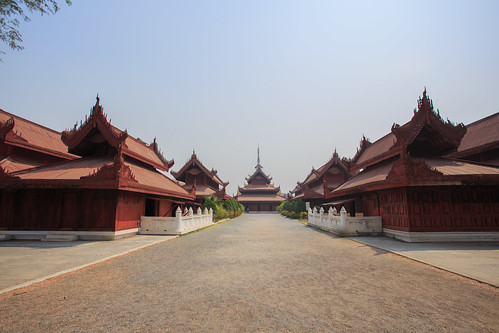 Palace quarters
Palace quarters
As opposed to the outside of the main palace, the inside was free to move. There was no guard or military man restricting your movement. You could go anywhere that the doors were open. Signs warned you where shoes were to be taken off; banners described buildings; the watch tower offered an amazing view of the palace.
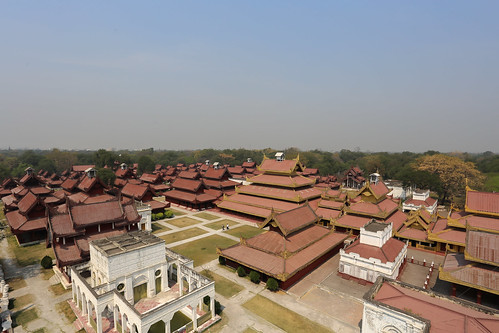 View from the watchtower
View from the watchtower
We walked around for a bit and clicked photos, accidentally walked in on couples having a private time in the backyard of the queen’s maids’ quarters, selected the most suitable quarter for residence, imagined and envied the daily routine of the royal family. Then we got a couple of glasses of sugarcane juice and pedaled out of the palace the same way we had come in. A couple of hours was all that was required for the palace and we had spent that much time here.
 The last king and queen of Burma
The last king and queen of Burma
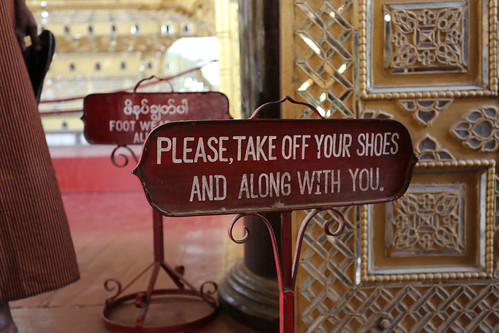 Funny?
Funny?
The sun was bright and harsh by now. We went to the Mandalay hill and parked our bikes next to the staircase. This was one of those few places where you had to pay to store your shoes. We did and started walking up the stairs. There were quite a few pagodas all along the staircase to the top. Parul’s research had told us that there was one pagoda worth seeing, the Kusinara Pagoda. This was also supposedly a little difficult to find. After the second flight of steps, there was a board with vague letterings declaring Kusinara on the left. That wasn’t so difficult to find! The stairs to the left led down again and almost at the base level we hit upon a gate that led into a room with golden leaves, owls and lizards painted on white walls. The colour combination looked very different because of the staccato bursts in which the colours came. A wooden Buddha face looked on with a mix of ecstasy and knowledge on his face. Another door led us to the inner chamber.
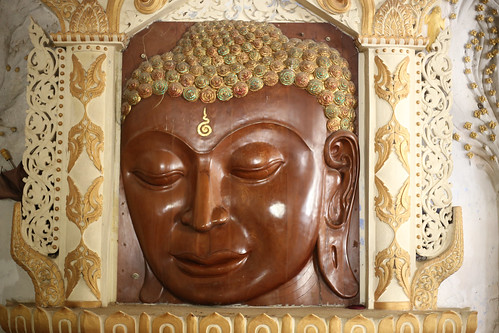 Wooden Buddha
Wooden Buddha
The walls continued the same pattern but the corridoors were now arches. The floor was tiled with brown swastikas and the lamps shed a very becoming yellow light in the room. We walked in and to our right a Buddha statue was doing what seemed to be the best thing to do in such a setting; lay down and rest your head on your arm.
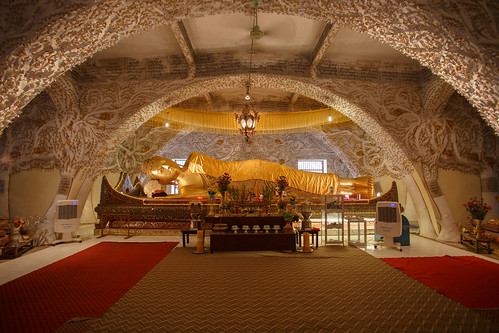 Reclining Buddha at Kusinara pagoda
Reclining Buddha at Kusinara pagoda
We sat down under a fan and decided to enjoy the coolness of the room. The sun had been harsh and hot outside. Kusinara offered us a much needed respite. There was no one else around. Just two young girls who practiced their English on us. They asked us our names and country. Told us their’s. When I asked, they explained that the school was off for the summers, which was why they were running around in this place. They were quite fascinated by Parul’s thanaka.
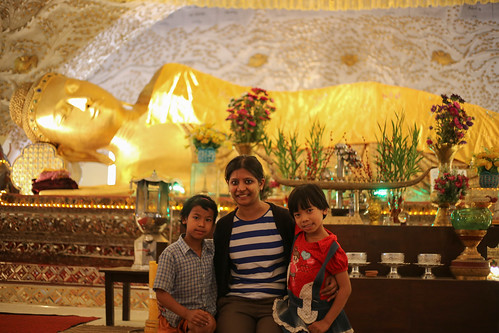 Burmese kids
Burmese kids
We talked to them and clicked a few photographs for the next ten to fifteen minutes. Then we decided it was time to get off our lazy asses and continue the climb to the top of the hill. As we were leaving, a few more tourists trickled in, never too many in number.
We slowly climbed to the top, breaking to watch little boys attempting stunts with chinlone or eating raw mangoes and drinking water. We crossed many statues and pagodas en route. Some had big Buddhas, some small; each in a different posture and stance. There was the famous statue of Buddha pointing towards Mandalay, prophesying the coming of a great city in that area.
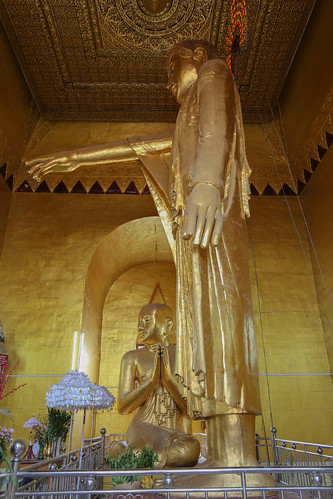 Prophesying Buddha
Prophesying Buddha
The good thing was that the entire staircase was shaded, else I doubt we would have made it to the top! The pagodas got a touch of glass work towards the top. The Buddhas were replaced by various other deities, probably survivors of older faiths.
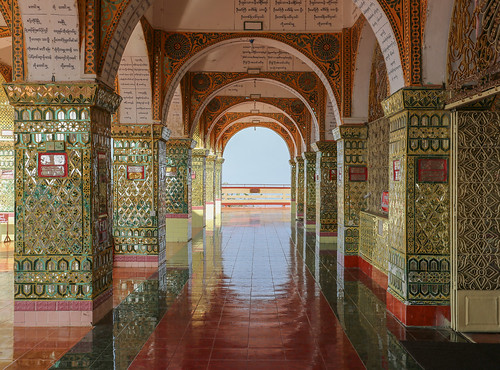 Glassy pagodas
Glassy pagodas
Once we made it to the top, we realised that it was nothing exceptional. It might have be better during sunset but in this season it was the haze that killed the view, whatever the vantage point. You could see most of Mandalay from up here. The Irrawaddy on the west was also clearly visible. To add to our frustration, we had to pay 1000 MMK for the summit! We had bought a 10000 MMK ticket for Mandalay area but the hill top demanded an extra 1000 MMK? It seemed rather ridiculous but we did not debate. We were too tired to.
We were approached by an Indian man. His name was Mahatma and he was third generation Burmese. His grandfather had been brought from India to work on plantations by a rich Indian landlord who had been gifted land in Burma. Since then his family had been in these parts. He was working in the jade industry now, and seemingly had come a long way from the position that his grandfather had found himself in. He was happy to meet Indians but had not visited India too often. Just four times in his life. His nephew, Abhay, had never been to India. He was there at the hill with his relatives. We were all introduced and talked a bit. He told us a little about the city and the preservation of the Hindu culture in the country. After some time we took his leave and retraced our steps down the stairs.
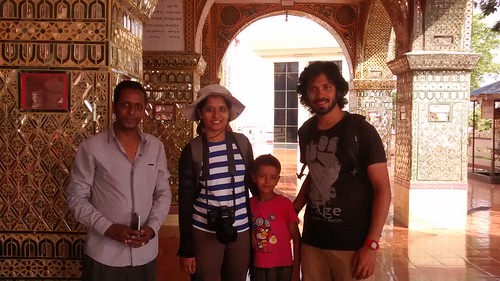 With Mahatma and Abhay
With Mahatma and Abhay
At the bottom of the stairs we sat down at a small shop for some food and more sugarcane juice. The food was another “Oh my God!” instance. Our hostess filled us up with food. I had ordered beef curry and just that had a spread of 7-8 bowls! Parul had shan noodles which were pretty good again.
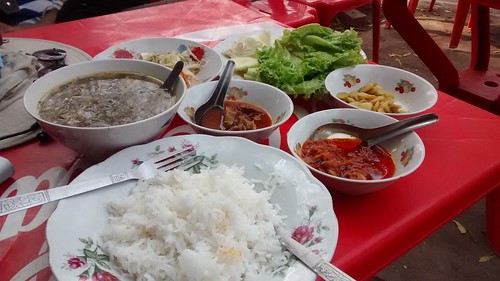 Before
Before
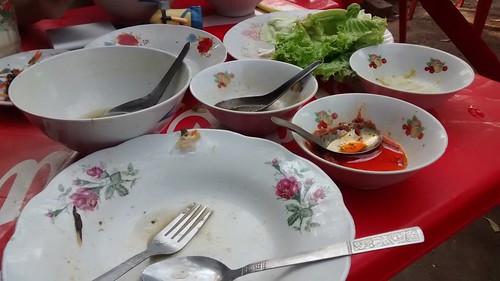 After; Burp!
After; Burp!
Myanmar Tip #4
Always wait for your ordered dishes to be laid out before you order more. You never know how many complimentary dishes might be on the way!
After the awesome lunch, we grudgingly returned to our cycles that were parked across the street and slowly pedaled to the pagoda and monastery complex to the immediate south-east of the Mandalay Hill. Parul had done some research last night and found out that these were the more interesting of the pagodas in the city. It was after four and although the heat was letting up a bit, our full stomachs had dulled our enthusiasm to see pagodas. However, the first of the lot, Kuthodaw Pagoda, seemed quite interesting. It was supposed to have the world’s largest book.
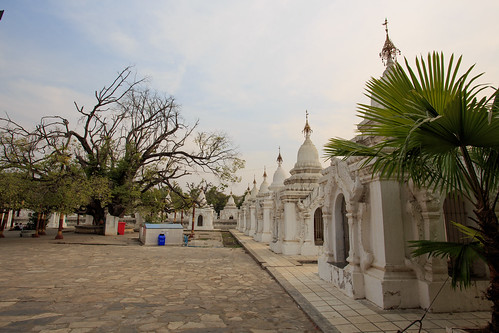 Startree and satellite pagodas
Startree and satellite pagodas
We approached Kuthodaw from the east and seeing an entrance, parked our bikes there. A man demanded 100 MMK for the bikes. Who the hell charges for bicycle parking! Anyway, we paid and went inside, leaving our footwear on the gate. We completed a circle of the pagoda. It looked beautiful. There were several tourists, a 123 year old star tree, beautiful white satellite pagodas sprawled all around the main one, but we did not find any book! I was supposing that the world’s largest book would be easy to spot. Confused, Parul asked me to check if she had not been mistaken about the name of the pagoda. Google offered a clue. Someone, in his reviews, had written that the book is set in stone. We rushed to the nearest white sub-pagoda and sure enough, instead of a Buddha image that is to be seen usually, there was a stone tablet with the book inscribed on it. We were standing IN the world’s largest book!
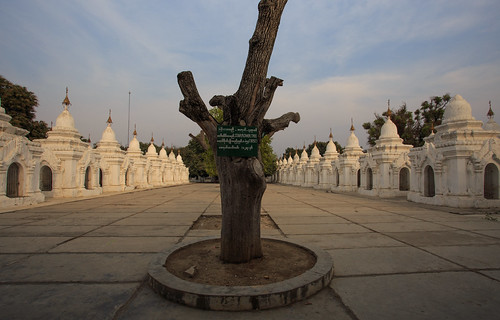 World's largest book
World's largest book
While Parul took photos, I went to the Western gate to collect our footwear since we would leave for the next site by foot from the southern entrance.
Myanmar Tip #5
Whenever you can, carry your footwear along inside a pagoda. Though letting it be on an entrance is usually safe, you might not want to leave from the same entrance that you came in. Also, carrying a plastic bag to keep the footwear in makes it easier to handle.
Quite happy with our discovery, we left for the next site from the southern gate. Our stupidity became evident now. There were signs speaking about the inscriptions and guides explaining the stone tablets to the tourists. It was much more obvious on this side. Next, we walked to the Shwenandaw Kyaung. This was a monastery similar to the one in Innwa. But the woodwork was much more detailed and beautiful.
 Shwenandaw Monastery
Shwenandaw Monastery
There was active restoration work underway in good taste. Inside there were carvings of Jataka stories well preserved. We saw signs that prohibited women from climbing into the main chamber in the monastery. Burmese culture was not without it’s misogyny!
 Restored woodwork
Restored woodwork
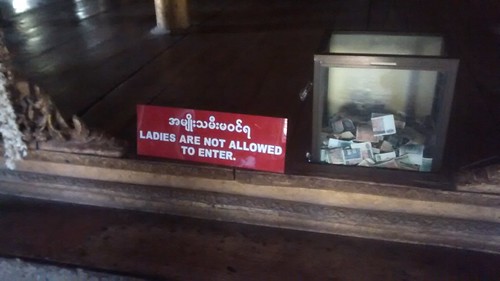 Not quite egalitarian
Not quite egalitarian
Next and last stop for the day was Sandamuni Pagoda, which was supposed to have the largest iron Buddha. We made a circle again but could not figure out where the largest iron Buddha was. We let it be and stopped to see the sun setting over the satellite pagodas.
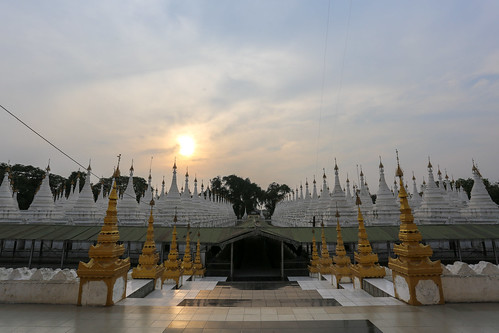 Sunset at Sandamuni
Sunset at Sandamuni
There were a bunch of Europeans nearby (seemed French to me by their language) who were clicking photographs and talking aloud. A young monk passed by and I saw him do a few double takes. I thought it was because he was disdainful of one of girls wearing her slippers on the pagoda. Parul told me that it was because two of them were kissing while they got their photos clicked! Such absurd disregard for other people’s sentiments can be a result of an unparalleled cultural arrogance. I was even more sure now that they had been French.
Booking Tickets & Nightlife
We were considering Hsipaw or Hopin (Indawgyi Lake) for our next destination. I had inquired about the tickets on the way back to the hotel from the Mandalay Hill trip but they had told me that the tickets for Hsipaw were over and the ones to Hopin would be available the next day from 6 AM. I was sure I had read about advanced bookings of tickets but if the counter was turning me away, there was no reason to suspect otherwise. Since Hsipaw would mean wasting another day (the train to Hsipaw runs at 4 AM in the morning), we chose Hopin instead.
I was up at 5:30 AM and was at the station counter five minutes before 6 AM. The counters were not yet open and the staff was preparing for the day’s work. People had already started waiting in lines. Not knowing which line to get in, since all the sign boards were in Burmese, I approached one of the counters and asked the gentleman inside where I could get tickets for Hopin. He stopped what he was doing and helped me very patiently, telling me the available options and the times they would reach Hopin. I chose the 10 AM option and the man pointed to another counter on the other side of the hall. The counter read Myitsone-Mandalar Express Train and was not open yet. But there was a line in front of it and I joined it. I waited till 6:15 before asking the person behind me what the opening time was. He told me 7 AM. A long line for more than an hour! I decided to go back to the hotel since it was nearby.
 Early morning queuing at ticket counter
Early morning queuing at ticket counter
Parul and I returned around 7:30 AM to inquire at the counter. There were only ordinary class tickets left. The upper class was sold out. We asked about sleeper trains and the man told us to go back to the main counter. We went there and were told that the sleeper train would depart the next day. We chose to spend the day in Mandalay rather than take the ordinary class and spend a day recuperating in Indawgyi. We bought the tickets which were all written on a piece of paper. The man used carbon copier for records which was kind of funny to remember. The fee was 17,800 MMK per person, not exactly cheap. This was approximately INR 900 for a 500 km journey! This was way more than what the trains here should have been worth. Anyway, with our tickets booked, we quickly found another hotel to spend the night and shifted base.
We had another OMG meal at a Chinese place, The Pyay. It was not your typical noodles and dumplings Chinese. This was quite different and extremely delicious as well. This was probably the most defining feature of Mandalay for me. The food was an amalgam of cultural influences from all the adjoining states. There was a bit of Shan, Kachin, Burmese, Chinese, Indian and what not to be found in the food here. You needed but to roam the streets and stop at any place (street side or otherwise) that piqued your interest.
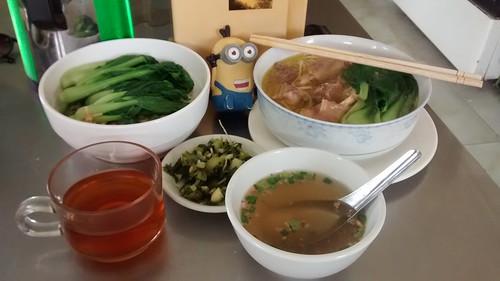 Awesome Chinese lunch
Awesome Chinese lunch
Towards the evening we walked till the Jewelery Market, only to find it closed. It was dark by the time we walked back and we saw the street side food joints cropping up. Some of these shops have a dish installed on a cart and a TV put up against a light pole. People huddle next to these makeshift entertainment arrangements. It is really quite amusing and ingenious.
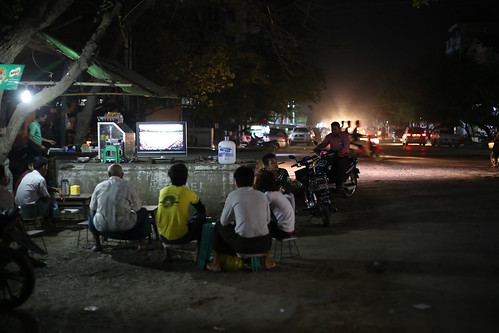 Roadside entertainment systems
Roadside entertainment systems
We could see an EPL match starting as we passed some of the joints; Arsenal vs. Tottenham Hotspur. Today promised to be a lively night. Myanmar loves it’s football, especially the English Premiere League. We decided to go sit in a beer station near our new hotel. This was Shwe Lat Yar Beer Station on the junction of 82nd and 31st streets.
Myanmar Tip #6
Mandalay and Yangon are well planned cities. Just the street number is usually enough to get you around in downtown.
We sat at the beer bar having some super cheap draught beer (only 700 MMK per glass), eating some starters and bitching about the pathetic level of football in the EPL. The only reason it is such a hit in the Asian markets, according to me, is because of they time it to air at our prime time. There is no other reason that someone would waste his time watching such bad football!
While we were about to wrap up, a man came and pulled a chair up to our table. He introduced himself as Salman, half Indian and half Burmese. He was communicating in uncertain Hindi and managed to tell us that he owned a lungi shop in Mandalay. He also said that I looked European (well…). We paid our bill, shook Salman’s hand and got up.
We were not done yet though. Parul wanted a picture of the lit up watchtowers of the palace reflecting in the moat. We walked all the way, happily drunk and making plans to do an MC Hammer Slide once we got there. But the trouble was that neither of us knew how to do it. No issue, YouTube to the rescue! We saw a funny video and tried out the hilarious steps once we got to the palace, laughing and wondering if the towers held snipers to shoot drunken idiots performing buffoonery in front of the palace. Parul finally got her photo as well and we returned to the hotel giggling like kids.
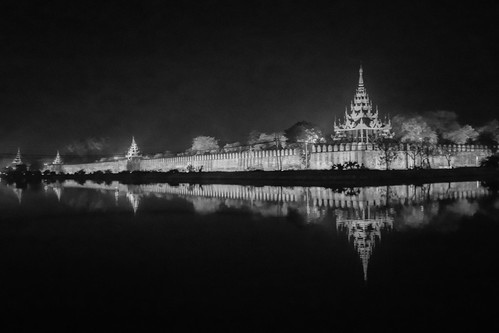 All along the watchtower!
All along the watchtower!
All bordered images are credited to [Parul](https://www.facebook.com/Captured-by-Paulina-1012929485421876/).
Whether you enjoyed the post or not, do leave a comment!
Previous post in this series :
And here is the complete album of the Mandalay leg of our trip.

